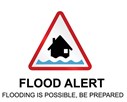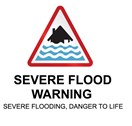Redbridge has multiple roles and functions, including as a Highway Authority, an LLFA (Lead Local Flood Authority), a landowner and a Category One Responder.
As a Highway Authority, Redbridge is responsible for maintaining any highway assets on adopted roads which are not on the Strategic Road Network (which is managed by TfL). Highway drainage, such as drains, kerbs, road gullies, ditches and pipes, have to be managed and routinely inspected to ensure that highway runoff on and from highways is well managed. Redbridge’s highway drainage responsibilities include highway gullies and pipework up to the point it connects to the public sewer network, where it becomes Thames Waters responsibility.
Surface Water
Surface water or flash flooding occurs when heavy rainfall exceeds the capacity of the ground and local drainage networks to absorb it. It can lead to water flowing over the ground and pooling in low-lying areas. It is typically caused by short intense rainfall. This is identified as the biggest risk in London. Whilst some gullies may be blocked, during storm events such as in July 2021 public sewers struggle to cope with the amount of rainwater which leads to flooding on the roads and pavements.
If water is still present after a few hours and you believe the issue is being caused by a blocked or damaged roadside gully, or if you wish to report another non-emergency drainage issue, please contact the local authority Highways team via phone on 0208 554 5000 or report it online.
There are gullies or drainage systems that are present in private estates or roads which are the responsibility of the landowner or private management company, usually shared ownership between residents. Significant structures and their owners where the information is provided by the 3rd party may be identified in the Flood Asset Register produced by the local authority which we are looking to bring online shortly. In the meantime please report the issue using the number or link above if you are unsure of the owner.
Where significant flooding has resulted in a property flooding the local authority will need to include this in their Flood Investigations please report this after the event to Thames Water and Redbridge.
Reservoirs
A reservoir is, most commonly, an enlarged natural or artificial lake, pond or impoundment created using a dam or lock to store water. There are a number of these may be managed by different companies and landowners.
Contact details of the responsible body will be displayed at each reservoir, who will have an onsite reservoir plan, however in an emergency please call the local authority on 0208 554 5000 who are responsible for offsite reservoir plans and alerting the wider public of the potential issue.
London Borough Redbridge has two reservoirs:
- Hainault Forest Country Park
- Valentines Park
The council has duties under Section 19 of the Flood and Water Management Act 2010 upon which it is appointed as the Lead Local Flood Authority (LLFA). The act requires the LLFA to undertake investigations for flooding incidents and events.
The act states on becoming aware of a flood in its area, a lead local flood authority must, to the extent that it considers it necessary or appropriate, investigate:
(a) which risk management authorities have relevant flood risk management functions, and
(b) whether each of those risk management authorities has exercised, or is proposing to exercise, those functions in response to the flood.
Where an authority carries out an investigation under subsection (1) it must:
(a) publish the results of its investigation, and
(b) notify any relevant risk management authorities.
Ordinary Watercourse
Roadside ditches normally belong to the adjoining landowner and not the highway authority, except where land has been acquired for new road building.
Consent is required from the Lead Local Flood Authority (LLFA) to undertake some works on an ordinary watercourse. If a landowner wishes to pipe, alter a pipe, or dam an ordinary watercourse, they should apply for consent from the LLFA by contacting highwaysg@redbridge.gov.uk
Where there is local authority owned land, we have a programme for clearance and maintenance. Where they are piped or culverted, this does not change the responsibility. Please contact highwaysg@redbridge.gov.uk to find out more.
 Flooding
Flooding



